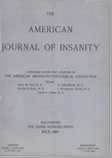THE PHYSICAL AND MENTAL STATES IN CHRONIC CHOREA
Abstract
We find then in chronic progressive chorea a varied ancestry, usually of a neurotic type, which shows that the disease has been present and was known in different countries (as for instance the German family shown on the chart) long before Huntington's description of the disease.
A careful examination of the personal histories reveals no disease of infantile or adult life to which the condition is ascribable. More accurate history of the ancestry and progeny of choreics is needed. The ratio of choreics to admissions to this hospital is 1 to 696.
Physical symptoms were most prominent, including convulsions in five cases. The sense of smell was more impaired than that of taste. Ocular movements of choreic nature occur. Many facial contortions were present. The choreic motions approximate 80 per minute. There was slight impairment of hearing and in a number cutaneous sensibility was impaired. Bulimia was a very marked symptom not previously given sufficient notice. The presence of tuberculosis was frequent. The onset of the disease is at about five-eighths of the age at which the disease manifested itself in the parents. Mental symptoms were noted at the onset oftener than physical symptoms, and homicidal tendencies were more pronounced than suicidal. The emotional conditions were chiefly irritability and indifference, varying to depression. In the stream of thought, food occupied the most prominent place. Only little hallucinosis was manifested and delusions of a vague persecutory type occurred but were poorly upheld. There was some attention, retention and memory impairment as well as impaired judgment and partial disorientation for time, place and persons. Impairment of the intelligence also occurred. There was more or less characteristic defect progressing toward dementia in practically all of the mental functions, leading to the conclusion that chronic progressive chorea has definite characteristic mental states with characteristic behavior, course and termination, while on pathologic examination there is found fairly definite pathology with widespread brain lesions, marked in the third and fourth layers of the cerebral cortex and more definitely marked in the basal ganglia and subthalamic regions.
[See table in the PDF file]
Access content
To read the fulltext, please use one of the options below to sign in or purchase access.- Personal login
- Institutional Login
- Sign in via OpenAthens
- Register for access
-
Please login/register if you wish to pair your device and check access availability.
Not a subscriber?
PsychiatryOnline subscription options offer access to the DSM-5 library, books, journals, CME, and patient resources. This all-in-one virtual library provides psychiatrists and mental health professionals with key resources for diagnosis, treatment, research, and professional development.
Need more help? PsychiatryOnline Customer Service may be reached by emailing [email protected] or by calling 800-368-5777 (in the U.S.) or 703-907-7322 (outside the U.S.).



